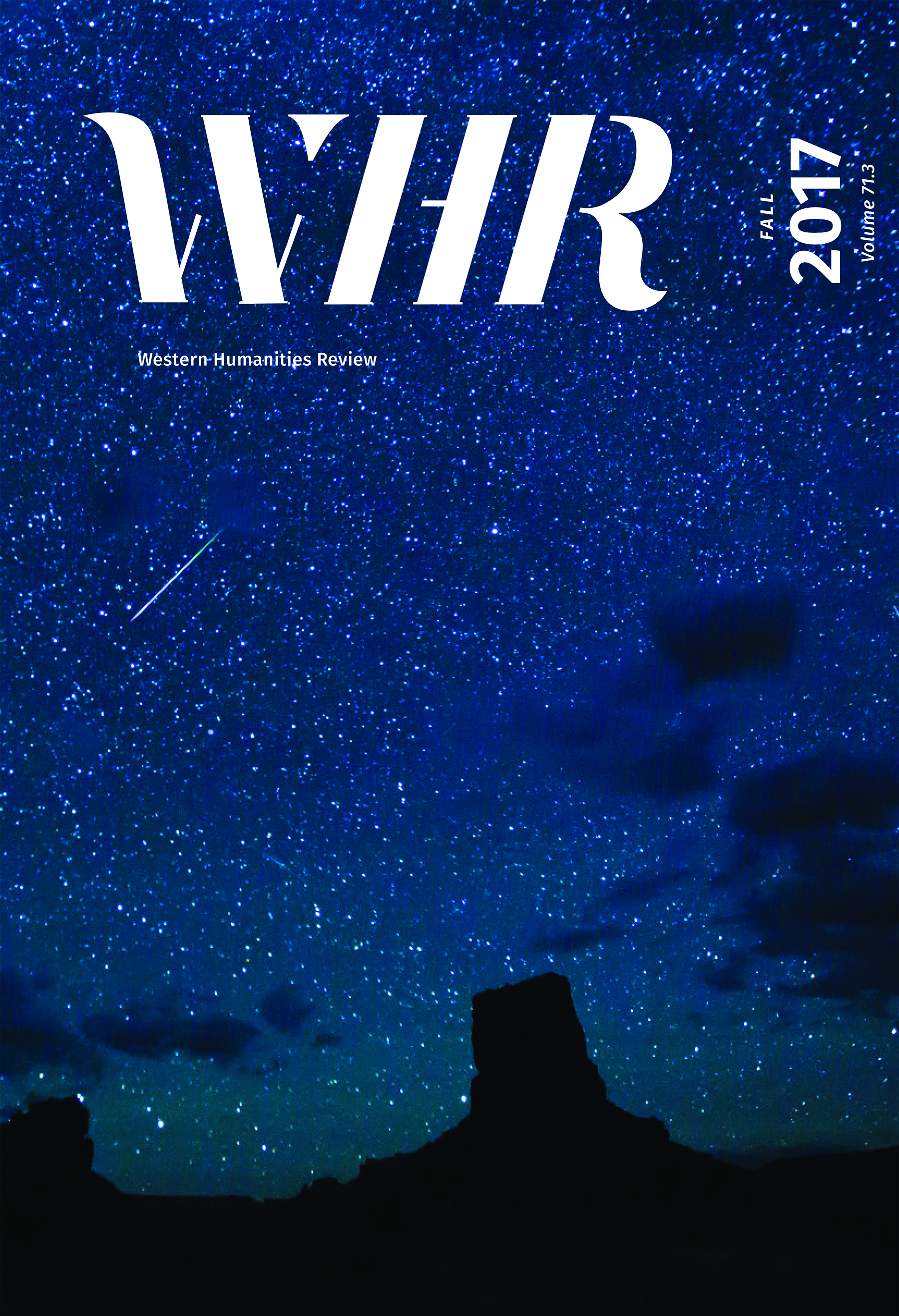Editor & Fiction Editor – Michael Mejia
Poetry Editors – Katharine Coles, Craig Dworkin, Thomas Stillinger
Nonfiction Editors – Stuart Culver, Jeremy Rosen
Managing Editor – Emily Dyer Barker
Consulting Editors – Barry Weller, Mindy Wilson
Print Design – Hailey Rabdau
Web Design – Adam Halstrom
Reviews Editors – Lauren Lipski, Michelle Macfarlane, Alyssa Quinn
Editorial Board – Scott Black, Vincent Cheng, Norman Council, Karen Lawrence, Michael Martone, Stephen Tatum
Cover Image – Bob Wick, “Perseid Meteor Shower in Valley of the Gods,” posted by Bureau of Land Management Utah, flickr.com, August 12, 2016.
WHR Special Issue
Guest Editor: Emily Dyer Barker
Photo Editor: Michelle Macfarlane
Editorial Assistants: Alyssa Greene, Kelly Longmore, Michelle Macfarlane
Western Humanities Review Special Issue:
The Creation and Reduction
of Bears Ears National Monument
Issue 71.3 features a chorus of voices expressing different perspectives—historical, personal, political, environmental, etc.–on the creation of Bears Ears National Monument by President Obama in 2016 and its subsequent reduction by President Trump the following year. The issue includes photographs by Gail Binkly (KSJD), Anna Fladmark, John Fowler, R Scott Jones, Wayne Pinkston, Kelsie Moore (KUER), and Bob Wick (BLM). Maps by Catherine Gilman (Archaeology Southwest), Stephanie Smith (Grand Canyon Trust), and others.
*
That the President of the United States is hereby authorized, in his discretion, to declare by public proclamation historic landmarks, historic and prehistoric structures, and other objects of historic or scientific interest that are situated upon the lands owned or controlled by the Government of the United States to be national monuments, and may reserve as a part thereof parcels of land, the limits of which in all cases shall be confined to the smallest area compatible with proper care and management of the objects to be protected.
—American Antiquities Act of 1906, enacted by
the 59th United States Congress
*
Two thirds of the state of Utah is public land, managed by the federal government.
*
In the 1848 Treaty of Guadalupe Hidalgo that concluded the Mexican-American war, Mexico ceded to the United States a large part of what is now the American Southwest, including the land that became Utah. With this cession, these lands were owned by the federal government and belonged to all U.S. citizens.
When Utah became a state in 1896, as part of its statehood agreement with Congress, Utah disclaimed rights to all the public domain lands within its borders. Some of these lands, however, were transferred back to the state to help pay for public schools. These lands are now managed by the State of Utah School and Institutional Trust Lands Administration (SITLA).
*
The Constitution’s property clause grants Congress authority over public lands. The Supreme Court has ruled that Congress enjoys broad discretion in determining how these lands should be managed, and over the years, public domain lands in Utah were reserved as national parks, national forests, and military reservations, or transferred into private ownership through the Homestead Act, General Mining Law, and other federal land transfer laws.
With the Antiquities Act of 1906, Congress delegated the President authority to designate national monuments to protect “objects of historic and scientific interest.” Employing this authority, presidents have created more than 100 national monuments, including several in Utah. Over time, Congress converted four of these Utah national monuments to national parks, namely Zion, Arches, Bryce Canyon, and Capitol Reef.
*
The congressional legislation and presidential proclamations establishing the national parks, forests, and monuments in Utah also directed how these various federal land designations were to be managed.
The remaining public domain lands stayed under the jurisdiction of the General Land Office (GLO) until 1946 when the Bureau of Land Management (BLM) was formed through the merger of GLO and the Taylor Grazing Service (which oversaw grazing on the public domain lands).
*
During the mid-20th century, federal policy shifted from land disposal to retention, culminating with the passage of the Federal Land Policy and Management Act in 1976. This law directed the BLM to manage the public domain lands under its jurisdiction for “multiple-use” purposes—to provide for a broad array of resource uses such as grazing, mineral development, and public recreation, while conserving wildlife habitat, cultural resources, and wilderness values where appropriate.
The “multiple-use” mandate has created inherent tensions between various interest groups, including ranchers, conservationists, energy developers, local communities, motorized and non- motorized recreationists, Native American tribes, state officials, and legislators among others, all of whom have a stake in how the BLM lands are managed. These groups have been embroiled in intense conflict for decades as each seeks to prioritize its own use of the public lands.
Currently, the BLM works with these constituent groups to develop land management plans designed to balance resource uses and values, but it faces a difficult task in deciding where the public interest lies for managing these lands, particularly when resolving the persistent debate about preservation versus use.


